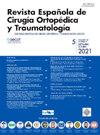用于居民培训的石膏移除模拟模型
Q3 Medicine
Revista Espanola de Cirugia Ortopedica y Traumatologia
Pub Date : 2025-06-09
DOI:10.1016/j.recot.2025.06.005
引用次数: 0
摘要
目的:脱模术后的并发症并不常见,但会引起永久性的皮肤后遗症。在住院医师期间,正式的脱模训练是有限的。本研究旨在为住院医师训练建立一个石膏移除模拟模型。MethodsQuasiexperimental研究。设计了一个带有温度传感器的儿童前臂假体来模拟前臂石膏的移除。6名没有拆除石膏经验的第一年骨科住院医师和2名专家进行了评估。住院医生接受了初步评估,随后是指导会议和最终评估。使用特定评分量表(SRS)、客观结构化技术技能评估(OSATS)指南、手术时间和温度测量来评估患者的表现。报告中位数得分和范围,并使用Wilcoxon检验比较训练前和训练后的表现。使用曼-惠特尼测试将专家得分与居民得分进行比较。统计学意义为P <; 0.05。结果患者OSATS评分(前22分,范围20 ~ 24分)显著提高;训练后25分(范围:25-28分)(P = .03)和SRS[训练前8.5分(范围:7-9分);10点后(范围:8-10)(P = .02)]。温度(P = 0.50)和手术时间(P = 0.09)无差异。住院医师培训后得分与专家比较,在OSATS (P = 0.16)、SRS (P = 0.11)、体温测量(P = 0.50)和手术时间(P = 0.09)方面均无显著差异。结论石膏石膏拆除模拟模型是一种有效的住院医师培训工具,可使住院医师达到专家级的技能水平。在培训后的OSATS和SRS评分中观察到显著的改善,突出了干预对这项技能的积极影响。本文章由计算机程序翻译,如有差异,请以英文原文为准。
[Artículo traducido] Modelo de simulación de retirada de yesos para el entrenamiento de residentes
Purpose
Complications from cast removal are infrequent but can cause permanent skin sequelae. Formal training in cast removal is limited during residency. This study aimed to develop a plaster cast removal simulation model for resident training.
Methods
Quasiexperimental study. A pediatric forearm phantom with temperature sensors was designed to simulate forearm cast removal. Six first-year orthopedic residents with no prior cast removal experience and two experts were evaluated. The residents underwent an initial evaluation, followed by an instruction session, and a final evaluation. Performance was assessed using a specific ratings scale (SRS), the Objective Structured Assessment of Technical Skills (OSATS) guideline, procedure time, and temperature measurement. Median scores with ranges were reported, and pre- and posttraining performances were compared using the Wilcoxon test. Experts scores were compared with resident scores using the Mann-Whitney test. The statistical significance was set at P < .05.
Results
Significant improvements in OSATS [(pre 22 points (range: 20-24); posttraining 25 (range: 25-28) (P = .03)] and SRS [pre 8.5 points (range: 7-9); post 10 points (range: 8-10) (P = .02)] were observed. No differences were found in temperature (P = .50) and procedure time (P = .09). When comparing residents’ post-training scores with those of experts, no significant differences were found in OSATS (P = .16), SRS (P = .11), temperature measurement (P = .50), or procedure time (P = .09).
Conclusions
The plaster cast removal simulation model proved to be an effective training tool for residents, enabling them to achieve expert-level competency. Significant improvements were observed in OSATS and SRS scores post-training, highlighting the positive impact of the intervention on this skill.
求助全文
通过发布文献求助,成功后即可免费获取论文全文。
去求助
来源期刊

Revista Espanola de Cirugia Ortopedica y Traumatologia
Medicine-Surgery
CiteScore
1.10
自引率
0.00%
发文量
156
审稿时长
51 weeks
期刊介绍:
Es una magnífica revista para acceder a los mejores artículos de investigación en la especialidad y los casos clínicos de mayor interés. Además, es la Publicación Oficial de la Sociedad, y está incluida en prestigiosos índices de referencia en medicina.
 求助内容:
求助内容: 应助结果提醒方式:
应助结果提醒方式:


